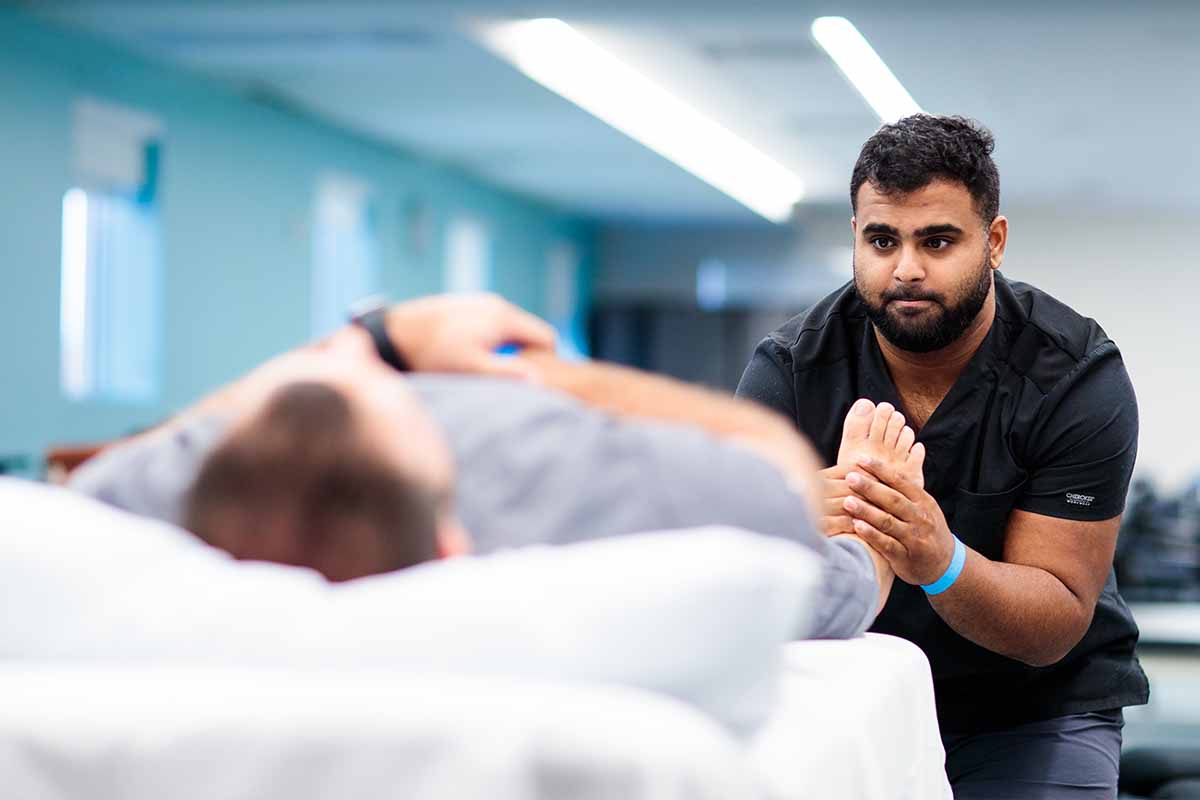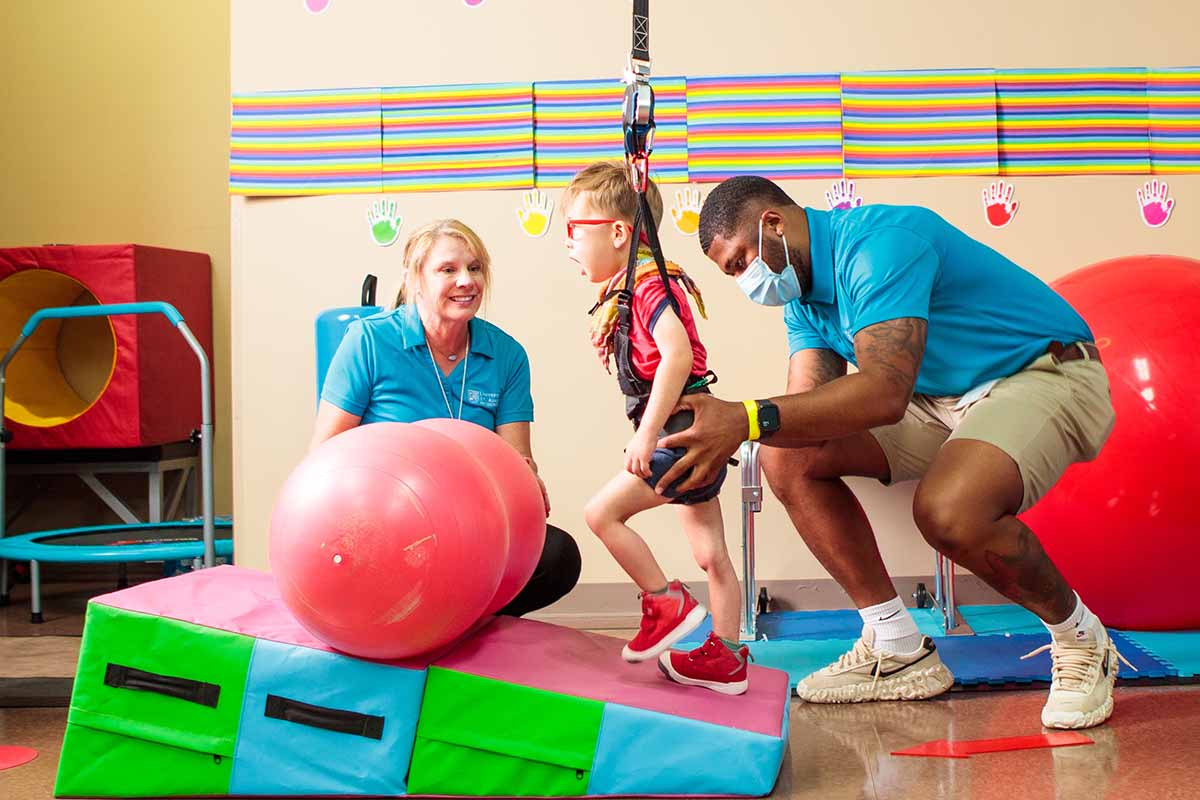
Becoming a physical therapist (PT) can be a long but rewarding process. You’ll need to earn a Doctor of Physical Therapy (DPT), the highest degree available in the field, to practice as a physical therapist. However, physical therapy school requirements are competitive, with more people applying than spots available in programs.
Learn how to get into physical therapy (PT) school and set yourself up for success.
10 Steps for Applying to PT School
Below is how to get into PT school, summarized in 10 steps:
Step 1: Earn Your Bachelor’s Degree in a Related Field
Start the process toward your physical therapy career by earning an undergraduate degree. While you can get a degree in any field, the best undergraduate majors for physical therapy students include:
- Biology
- Health Science
- Kinesiology
- Exercise Science
- Psychology
If you earn an undergraduate degree in another field, you can apply for physical therapy school if you complete PT school prerequisites. These commonly include the following areas:1
- Anatomy
- Biology
- Chemistry
- Physics
- Physiology
- Statistics
The prerequisites for PT school programs may differ, so check what your dream physical therapy school requires.
Step 2: Research PT School
If you decide to attend physical therapy school, research the 308 accredited PT schools in the United States.2 Choosing a graduate school can be stressful, but focus on finding schools that meet your needs.
As you research, aim to find several options. Getting into PT school is competitive, so you’ll want several backup options.
Step 3: Complete Physical Therapy Observation Hours
Before applying, you’ll need to earn physical therapy observation hours. Many PT schools require applicants to have a certain number of hours volunteering, observing or working in a physical therapy setting to ensure they have experience and are familiar with the discipline. The licensed physical therapist you work with must document your hours.
Some PT schools will allow you to apply as you work toward your observation hours. For example, at USAHS, you need at least 40 physical therapy observation hours, and 20 completed hours are required to apply. If accepted, you must prove you completed the 40 hours before you begin the program.
Contact local physical therapy settings, such as hospitals, nursing homes or rehabilitation centers, to ask if you can volunteer to meet your requirements for PT school admission. They may require you to meet specific requirements, such as passing a background check.
Step 4: Study for and Take the GRE


Most PT schools require applicants to take the Graduate Record Examination (GRE).1 This test evaluates your verbal and quantitative reasoning and analytical writing skills— expertise you will need for success in a graduate program.
The average GRE score for a DPT program varies by school. For example, the average GRE score for DPT students accepted at the University of St. Augustine for Health Sciences (USAHS) is 294-305 (combined verbal and quantitative reasoning) and a 4.0 on the exam’s written portion.
If your PT school requires you to take the GRE, start studying about three months in advance.3 The Princeton Review recommends taking the GRE while you are still in college since you’re already used to studying and taking tests.4 Your score is valid for up to five years.
Schedule your test about four months before you want to submit your application.5 This will give you time to get your score and retake the test to earn a higher score if necessary to meet your physical therapy school requirements.
Step 5: Ask for References
Many PT schools require you to submit letters of reference with your application. Ask people who:
- Know you well
- Meet the requirements for physical therapy school set by the institution you’re applying to
- Are knowledgeable in physical therapy (professors, physical therapists, etc.)
- Can speak to your relevant physical therapy skills, such as compassion, communication and dependability
To get the best letters of reference, establish relationships with your undergraduate professors, mentors, observation supervisors and other licensed physical therapists. Be engaged, ask questions and follow through whenever you interact with them.
Once you’ve established a relationship, explain that you need a letter of reference to meet one of your physical therapy school requirements and ask if they would be willing to write one. It’s best to ask in person, but you can also email them if you don’t see them regularly. Ask as soon as possible to give them plenty of time to produce a well-written and thoughtful letter—two to four weeks is usually sufficient.
If they agree, give them a copy of your resume so they can easily reference your experience and accomplishments. Ask when they might expect to complete the letter and follow up closer to that date.
Step 6: Write Your Personal Statement


Most PT schools require you to submit a personal statement, sometimes called a statement of purpose. This brief essay allows you to show who you are beyond your GPA and test scores—it’s your chance to set yourself apart from other applicants.
The PT school may ask specific questions, or they may ask for a general statement. Regardless, write about something that:
- Demonstrates your understanding of physical therapy
- Identifies your career goals
- Explains what you offer the school
- Is uniquely you
Many people choose to write about their first experience with physical therapy, such as a time when they or a family member were injured and needed to receive physical therapy. You can write about something other than physical therapy, unless the school asks for it specifically, if you respond to the prompt and showcase essential skills for physical therapists, such as compassion.
Give yourself plenty of time to write your personal statement. It’s best to wait a few days after you write your first draft before you edit it, and you’ll want to ask at least one other person to read it before you submit it.
Step 7: Gather Necessary Documentation
Start gathering the necessary documentation to submit with your application. Physical therapy school requirements will vary depending on the institution, but expect to submit the following:
- Transcripts for your undergraduate degree and any additional coursework
- GRE scores
- Resume
- Verified volunteer/paid physical therapy observation hours
- Personal statement
If you apply through the Physical Therapist Centralized Application Service (PTCAS) or a PT school’s online portal, you may only need to submit digital copies of the documents.6 You can also have your GRE scores sent directly to the PT school.
Step 8: Complete and Submit Your Application
Once you have the required information, complete and submit your application for PT schools. Most use the PTCAS, so you’ll only need to complete one application to submit to multiple schools.
While waiting for your acceptance letter, keep working or volunteering in a physical therapy setting to gain experience and make additional connections in the field.
If your application gets denied initially, don’t lose hope. Continue to apply to other places or address weaknesses in your application, such as a low GRE score, and reapply.
Step 9: Schedule Your PT School Interview
A PT school may contact you for an interview. Some require an interview to get to know your personality and evaluate skills, such as compassion, communication and collaboration, that aren’t always recognizable on an application.
Ask what to expect when the school reaches out to schedule the interview. Some PT school requirements may include interviewing with one faculty member, while others may have you interview with a panel of faculty and students.
Ask the following questions:
- Who will I be interviewing with?
- How long will the interview last?
- What should I expect during the interview process?
Step 10: Practice for Your Physical Therapy School Interview


Once you know what the interview will be like, take time to practice. Look up common PT school interview questions and jot down key talking points. Then, enlist friends and relatives to help you practice.
When you feel more comfortable, ask classmates, professors or any licensed physical therapists you know to help, treating these mock interviews like the real thing—dress professionally and practice everything from the opening handshake to walking out the door. You may want to record yourself in a practice interview so you can see your body language.
The more you practice, the more comfortable you’ll be in your PT school interview. This will allow you to make the best impression.
Five Tips to Get Accepted into PT School
The process of how to get into PT school isn’t easy, so here are a few additional tips to help you navigate the process.
1. Keep Your Undergrad GPA High
One of the best things you can do to meet your physical therapy school requirements is to keep your GPA high while earning your undergraduate degree. A low GPA is hard to overcome on your application, and a higher GPA can help you qualify for scholarships for your DPT program. Aim for at least a 3.0.
2. Build Relationships with Physical Therapists
Before you apply, take some time to build relationships with physical therapists. They can serve as references on your application, help you reach your physical therapy school requirements for observation hours and possibly help you get a job as a PT after graduation. Start working in a physical therapist’s office or volunteering in a physical therapy setting as soon as you know you’ll apply to physical therapy school.
3. Ask Someone To Review Your PT School Application
Before you hit the submit button, ask someone to review your application. Admission is competitive, so ensure your PT school application is flawless, and having another set of eyes to review it can catch any errors. Ask a professor, colleague or trusted mentor.
4. Take the GRE More Than Once
If you don’t get the GRE score you want the first time, you can retake it and submit your best score. You can take the exam as many as five times in 12 months if you wait at least 21 days before retaking it.7 If you decide to retake it to meet physical therapy school requirements, focus on improving your weakest areas. The GRE is expensive, so only take it more than once if you devote time to improving your score
5. Start Your Application Early
Applying to PT school takes time—you’ll need to track down paperwork like transcripts, wait for people to write letters of reference, potentially take the GRE more than once and write the perfect personal statement. Allow yourself at least six months to complete the entire process of how to get into PT school.


How to Get into Physical Therapy School FAQ
Below, we’ve answered a few more questions about how to get into physical therapy school.
Is It Hard to Become a Physical Therapist?
The process of how to get into PT school is competitive, mainly due to the limited number of available programs. A GPA of at least 3.0 is required, along with completion of specific courses, a personal statement essay and an interview for admission.
What Are Common Physical Therapy School Requirements for Admission?
The most common PT school requirements for admission are:8
- A bachelor’s degree in a related field
- Coursework completed within the previous seven–10 years in the following areas:*
- Anatomy
- Physiology
- Biology
- Chemistry
- Physics
- Psychology
- Statistics
- A minimum GPA (usually 3.0)
- GRE scores
- Volunteer or paid experience working in a physical therapy setting
- One to four letters of reference
- An interview
- State residency requirements
- Passing a criminal background check
- Technical standards and essential functions
How Many Years Does It Take to Become a Physical Therapist?
It can take seven to eight years to become a physical therapist. This includes four years to earn a bachelor’s degree and about three years to earn a DPT. However, accelerated programs are available to shorten this time like USAHS’ Residential DPT program, which can be completed in 2.3 years.**
How Much Do Physical Therapists Make?
Physical therapists make an average of $99,710 annually, with the top 10% earning $130,870 each year.9
Do You Have to Go to Medical School to Be a Physical Therapist?
You do not need to attend med school to be a physical therapist. However, you must earn a bachelor’s degree and then your DPT to practice.
Apply to USAHS’ DPT Program Today
Applying to PT school may seem daunting, but it doesn’t have to be. Learning how to get into physical therapy school before you start the application process can help you know what to expect so you can submit the best possible application.
Apply now for USAHS’ Doctor of Physical Therapy (DPT) program. The program is available in Residential, Flex, and Hybrid Immersion*** formats. You’ll experience hands-on physical therapy training, clinical experiences and research opportunities from a leader in physical therapy education since 1979.
*USAHS recommends that coursework is completed within the past 5 years – this is a preferred duration but not a requirement to apply.
**Time to completion may vary by student, depending on individual progress, credits transferred and other factors.
***The University of St. Augustine for Health Sciences (USAHS) is seeking approval from the Commission on Accreditation in Physical Therapy Education (CAPTE) for an expansion of its Doctor of Physical Therapy (DPT) program at its San Marcos, CA, and Miami, FL, campuses with a Hybrid Immersion model. Approval of the expansion programs is required prior to implementation.
Applicants interested in the Hybrid Immersion DPT format should contact an enrollment advisor using the request for information form on our site.
Salary data may not reflect starting pay for recent graduates.
Sources
- American Physical Therapy Association, “DPT Admissions Process,” APTA, 2024, https://www.apta.org/your-career/careers-in-physical-therapy/pt-admissions-process.
- Physical Therapist Assistant Centralized Application Services, “List of PTCAS Programs,” APTA, 2024, https://ptcasdirectory.apta.org/39/List-of-PTCAS-Programs.
- The Princeton Review, “How to Study for the GRE,” The Princeton Review, https://www.princetonreview.com/grad-school-advice/how-to-prepare-for-gre.
- The Princeton Review, “Why Rising College Seniors (and Recent Grads) Should Take the GRE,” The Princeton Review, 2024, https://www.princetonreview.com/grad-school-advice/why-college-seniors-should-take-the-gre.
- The Princeton Review, “Graduate School Application Timeline,” The Princeton Review, 2024, https://www.princetonreview.com/grad-school-advice/application-timeline.
- American Physical Therapy Association, “PTCAS: Physical Therapist Assistant Centralized Application Service,” APTA. https://www.apta.org/cas/ptacas.
- Riley Stoltenberg, “How Many Times Can You Take the GRE?,” Test Prep Insight, February 27, 2024, https://testprepinsight.com/resources/how-many-times-take-gre/.
- American Physical Therapy Association, “DPT Admissions Process,” APTA, 2024, https://www.apta.org/your-career/careers-in-physical-therapy/pt-admissions-process.
- U.S. Bureau of Labor Statistics, “Physical Therapists: Pay”, Occupational Outlook Handbook, April 17 2024, https://www.bls.gov/ooh/healthcare/physical-therapists.htm#tab-5.










